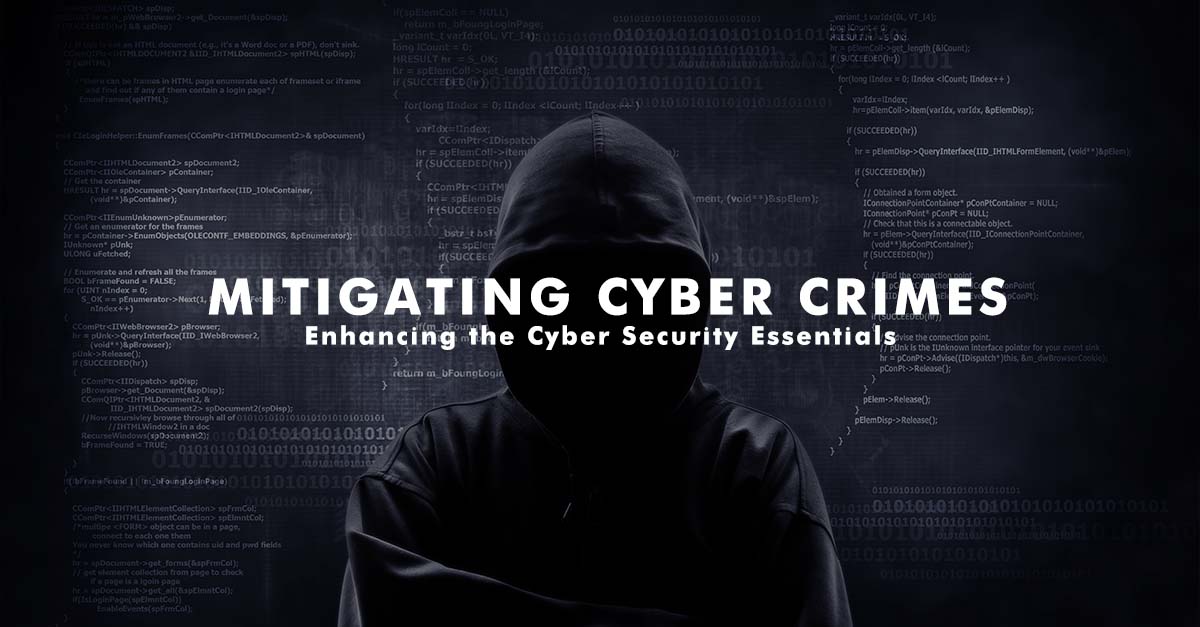
Mitigating Cyber Crimes: Enhancing The Cyber Security Essentials
“Mitigating Cyber Crimes remain some of the topmost priorities among organizations. A healthy cyber security business environment not only prevents financial losses and business processes; but also tackles customers’ interests, thus enhancing business reputations.”
Businesses work in a more competitive environment these days.
The digital transformation resulted in the companies going digital, aligning with the latest emerging technologies and innovation.
Just like the COVID-19 pandemic resulted in the Digital Revolution, Industrial Revolution 4.0, giving the digital transformation opportunities for businesses, it has also resulted in rising cybercrimes among businesses.
Among the organizations across the sectors; any business practice faces cyber risks that often lead to increased risks of the downfall of business units and processes.
Cybercrimes have emerged as one of the significant threats to digital transformation.
As the organizations have made their business processes digital, it has also resulted in the rising challenges in cybercrime. Cybercriminals have outpaced digital organizations with their tech-savvy skills.
Hacking an entire organization and its business practices have become more accessible than ever with the ease of cybercriminals’ attacks on business practices.
Whether data, business process, a simple algorithm, or a mere integration, almost everything gets exposed to cybercriminals with utmost ease.
Cyber Crimes – Rise in Digital Threats:
Organizations have become more vulnerable and susceptible to cyber threats owing to the recent rise in cyber security breaches.
As businesses become more independent, the risks of cyber threats increase. The lack of identification of cybercrimes in real-time; absence of infrastructure, and a well-defined risk mitigation plan results in the cybercrimes.
The rise in instances of cybercrimes resulted in organizations making cybersecurity one of the major concerns.
According to a recent research study, an average of 68% of the organizations across all sectors reports having cybersecurity on the leadership agendas quarterly, whereas 32% of organizations indicate tackling cybersecurity is one of the significant leadership strategies.
On one side, the rising digital connectivity makes the world feel like home, bringing them together; on the other hand, it poses more significant risks of cybercrimes among organizations.
A recently conducted survey reveals that almost 60% of organizations believe that they are highly resilient to cloud-based risks, whereas 36% of respondents believe that they are risk resilient to some degree.
In comparison, 4% of respondents reveal that they are not at all resilient to risk.
Such figures are alarming and call for immediate action from upper management to tackle the existing risks and create a risk resilience environment for the unprecedented cyber crimes risks in the upcoming days.
Most Common Cyber Risks Elements:
Cyber risks are increasing due to the digitization of business practices. Overexposure to cyber risks and an absence of a well-placed cyber risks defense system result in rising cyber threats cases.
Cyber attacks are more common than ever these days on a common level, and dealing with them remains the topmost concern among business leaders.
Absence of Risk Advisory Services:
The cyber risks are there, and the organizations are well aware of rising instances of risks and the required steps to mitigate them.
The lack of implementation of a well-defined risk aversion plan, complying with the latest regulatory trends results in more risks.
Cybercrimes and cyber frauds committed these days are new, and hence, combatting them require innovative and unique agile solutions, unlike the old traditional practices to avert cyber threats.
Implementation Mode:
Cybercrimes vary in nature. Even a common phishing email is potential enough to knock down the entire business practice of an organization.
Cybercriminals are tech-savvy these days and use the latest and innovative malware and ransomware practices to commit cybercrime.
Organizations focus on implementing the tools and modes to combat such risks.
Still, the lack of a proper implementation customized as per the latest nature of the cybercrimes costs the organizations facing more cyber risks.
Operations and Training:
Lack of operational infrastructure and absence of expertise and training result in cyber threats in an organization.
The organizational structure comprises large departments, small units, and medium enterprises, and each varies in the mode of its operations.
It is often cumbersome to invest in the operational capacity in training g practices on tackling cyber threats.
Cybercrimes have become sophisticated with the rise in instances of unprecedented and innovative scenarios in how they are done.
Enhancing the Cyber Security Essentials:
With the rise in cybersecurity threats, organizations are adopting cyber risk mitigation strategies by identifying the potential cyber risks, assessing them, and mitigating the same with a robust risk mitigation plan.
These risk mitigation plans are essential to curb the cyber risks and a tool to avoid future risks but embed the overall business tools and practices.
Organizations focus on the following tools to enhance the cyber risk mitigation plans.
Infrastructure Protection:
Organizations sometimes focus on implementing the cyber risks mitigation plans to tend to forget the overall infrastructure that may result in the combined significant potential risks.
The infrastructure protection approach focuses on addressing the overall risks by considering security architecture, data protection policies, product security plans, configuration strategies, third-party integrations, cloud risk management, among others.
Access Management Tools:
Mitigating the cyber risks is not a one-way approach. It’s an all-new plethora of business management tools that lead to achieving a safe business environment.
Focusing on access management tools such as two-factor authentication, identity architecture design, role-based access control, and source code reviews mitigates cyber risks and creates a risk-averted business environment.
Advanced Readiness:
Preparation in advance often leads to success. The same goes for cyber risk mitigation plans.
Adopting advanced threat readiness plans such as integration with security monitoring, implementation of security information and event management (SIEM) design, brand monitoring, advanced cyber analytics, and cyber-surveillance help fetch fruitful results by combatting cyber risks.
Conclusion – Cyber Crimes:
Cyber risks have been common for a long.
Due to the digitization of business practices, cyber threats have surged exponentially.
Combatting cyber threats is not a one-way process but a multitude of well-defined risk aversion and mitigation plans.
Adopting risk mitigation plans that focus on the entire business practice and organizational structure leads to a better risk-free business environment.





